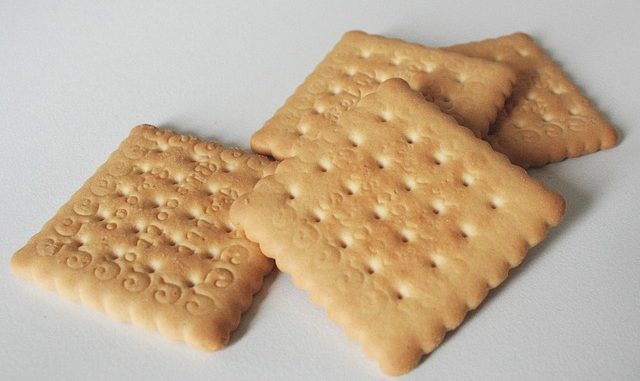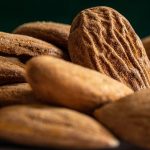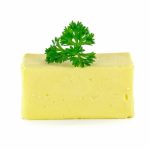
Consumption of biscuits is rising throughout the globe. Much of the increase is fuelled by improving lifestyles. Semi-sweet biscuits are the very type of baked product that has enjoyed a resurgence because of how healthy they can be made (Krystyjan et al., 2015).
One of the staples of the grocery list is the biscuit and possibly rivalling cookies would be hard, semi-sweet or sweet biscuits. The emphasis however is on the ‘hard’. Texture is all important here and there are a number of varieties available for the delectation of the consumer.
Biscuit dough is prepared from four main ingredients:
- wheat flour
- fat
- sugar
- water
A biscuit generally has a low fat and sugar content. The water content is relatively high and allows the gluten network or matrix to develop during mixing and proving (Flint et al., 1970).
Biscuit Processing & Baking
Biscuit processing involves a series of well-defined steps that transform raw ingredients into the final baked product. The process requires precision and control at each stage to ensure the desired quality, texture, flavor, and appearance of the biscuits.
Below is an outline of the typical steps involved in biscuit processing:
1. Ingredient Preparation and Scaling
- Raw Material Selection: Quality ingredients such as flour, sugar, fats, leavening agents, milk solids, and flavorings are selected. The choice of ingredients influences the biscuit’s texture, flavor, and appearance.
- Weighing and Measuring: Ingredients are accurately weighed and measured according to the recipe to maintain consistency and quality.
2. Mixing and Dough Formation
- Creaming: For certain types of biscuits, such as shortbread or butter biscuits, fats (butter or margarine) and sugar are creamed together to incorporate air, creating a light texture.
- Dough Mixing: The other ingredients, including flour, water, milk, and flavorings, are mixed into the creamed mixture to form a dough. The mixing time and speed depend on the desired dough consistency and biscuit type.
- Incorporation of Additives: Leavening agents (such as baking powder or baking soda) and other additives like salt, emulsifiers, or preservatives may be added during this stage.
3. Dough Resting
- Resting: The dough may be rested for a period to allow the flour to hydrate, fats to firm up, and gluten to relax. This resting period can improve dough handling and the final biscuit texture.
4. Dough Sheeting and Rolling
- Sheeting: The dough is passed through rollers to form a continuous sheet of the desired thickness. The thickness of the dough sheet will influence the final thickness and texture of the biscuits.
- Lamination: For certain types of biscuits, the dough may be folded and rolled multiple times (lamination) to create layers, contributing to a flaky texture.
5. Dough Cutting and Shaping
- Cutting: The dough sheet is cut into desired shapes using rotary cutters or stamping dies. The shapes can vary from simple circles to intricate designs, depending on the product requirements.
- Embossing and Docking: Embossing can be done to imprint designs on the biscuits, while docking (pricking small holes) helps to control the expansion and prevent puffing during baking.
6. Baking
- Oven Loading: The cut dough pieces are transferred onto baking trays or directly onto the oven conveyor belt.
- Baking: The biscuits are baked at specific temperatures and times, depending on the biscuit type. Baking involves several stages, including:
- Evaporation of Moisture: The dough loses moisture, causing the biscuits to dry and firm up.
- Expansion: Leavening agents cause the dough to rise, giving the biscuits a light texture.
- Color Development: The Maillard reaction and caramelization contribute to the biscuit’s color and flavor.
- Oven Types: Different ovens, such as rotary ovens, tunnel ovens, or convection ovens, can be used, each offering different baking characteristics.
7. Cooling
- Cooling: After baking, the biscuits are cooled to room temperature to set their structure and prevent condensation when packed. Proper cooling is crucial to maintain the crispness and prevent the biscuits from becoming soggy.
8. Quality Control and Inspection
- Inspection: Biscuits are inspected for uniformity in size, shape, color, and texture. Automated systems or manual inspection can detect defects.
- Sampling and Testing: Random samples may be tested for moisture content, texture (crispness), and flavor to ensure they meet quality standards.
9. Packaging
- Packaging Types: Biscuits are packaged in various formats, such as plastic trays, boxes, bags, or tins, depending on the product type and market requirements.
- Sealing and Labeling: Packages are sealed to preserve freshness and extend shelf life. They are then labeled with product information, such as brand, ingredients, nutritional information, and expiration date.
10. Storage and Distribution
- Storage: Finished products are stored under controlled conditions to maintain quality before distribution. Temperature and humidity levels are monitored to prevent spoilage.
- Distribution: Biscuits are distributed to retailers, wholesalers, or directly to consumers. Proper handling during distribution is essential to prevent breakage and maintain product integrity.
Each step in the biscuit processing workflow plays a crucial role in ensuring the final product meets the desired quality standards. From ingredient preparation to packaging, careful control and monitoring are essential to produce consistent, high-quality biscuits. With advancements in technology, many of these processes are increasingly automated, allowing for greater efficiency, consistency, and scalability in biscuit production.
The Impact On Gluten
Biscuit processing as with any baked product is generally about how the dough is handled. With biscuits, it is commonly sheeted and laminated over a number of steps. This is all intended to work the gluten structure or network as it is often called. That gluten network is stretched and aligned in the direction of sheeting (Levine and Drew, 1994).
Allowing the dough to relax for a short period of time before cutting means the gluten network can consolidate and develop the required amount of elasticity and stressed structure. The dough naturally shrinks as the network develops but if the stresses and strains are inconsistent, oval biscuit shapes can form instead of the desirable round shapes.
Dough Rheology.
Dough rheology is an important feature for any baked product. It is fundamental to how the dough performs when being mixed and rested. Excessive dough contraction is undesirable as already mentioned because misshapes will commonly form. Anyone who has bought ‘factory’ biscuits can testify to some of the weird and wonderful shapes created.
To help reduce dough contraction means adding gluten-modifying agents. The gluten contains intermolecular and intramolecular disulfide bridges. These are cleaved (broken) by adding some sodium metabisulphite (SMS). It is for this purpose that SMS is an excellent antimicrobial as well as an antioxidant. Breaking the disulphide bonds also reduces the molecular weight of proteins as well as increasing the elasticity and extensibility of the dough (Stauffer, 1994). The maximum level of of added SMS is 450 ppm based on the amount of flour in the formulation. Apparently it even helps extend dough length.
As with bread making, large deformation methods are employed such as the farinograph and extensigraph (Oliver et al., 1995).
Proteases
Proteases in biscuit making improve dough handling and quality. The pH of biscuit dough is between 6 and 8 so bacterial proteases are the most effective because their optimum range is similar. Such enzymes break and modify gluten, certainly reducing their molecular weight. This also reduces dough viscosity and dough extensibility.
Rich Tea
The most basic perhaps would be the infamous ‘Rich Tea’. This sweet biscuit is simply prepared from just four main ingredients: wheat flour, sugar, vegetable oil and malt extract. The key carbohydrate is sugar with a little provided by the wheat flour. Protein comes from the flour and coupled with the shortening or fat is the main contributor to texture. The higher the protein content, the harder the biscuit. The higher the nitrogen content in the protein, the harder the biscuit. That mind simplistic as there are so many other factors at play but its not far off.
Back to the Rich Tea biscuit. It was established in the 1600s in the county of Yorkshire in England and was designed for those who could afford a light snack product of sugar in between full course meals. It is now regarded as the ideal dunking biscuit for both tea and coffee. Established brands include McVitie’s, but a number of own-label brands exist. Cadbury’s produce a rich tea type biscuit with a surface layer of chocolate which is very popular.
The finger variety is known as Rich Tea Creams which have a vanilla cream sandwiched between two biscuits which are produced by Fox’s.
Digestive
The second example is the digestive. This was produced in the UK by two Scottish doctors as a means of helping overcome gastrointestinal problems in 1839. It was prepared from various grain flours with substantial quantities of fibre. One very famous company Huntley & Palmers in 1876 developed a specific recipe which is described in Cassell’s “New Universal Cookery Book” of 1894. This became the forerunner of all those digestives.
Digestive biscuits usually contain coarse brown wheat flour which lends this biscuit a distinctive texture and flavour, along with sugar, malt extract, vegetable oil, wholemeal and raising agents which are usually sodium bicarbonate, tartaric acid and malic acid and salt. A few varieties often have dried whey, oatmeal, cultured skimmed milk and various emulsifiers.
Nutritionally, two biscuits would be a typical serving and will have the following profile:- 140 calories, 6 grams of fat, 19 grams of carbohydrate, 1 gram of fiber, 5 grams of sugar, 2 grams of protein and 160 milligrams of sodium. Whilst digestives are not sources of vitamins or minerals, there have been attempts to fortify with extra fibre, iron as with the use
The digestive is ideal for weight management as it’s a fine vehicle for wholemeal flours. A typical serving would be two biscuits. usually, digestive biscuits are not a great or even significant source of fibre but there are many biscuits now containing beta-glucan and a heart- healthy fibre. On average we need 14 grams of fibre for every 1,000 calories consumed which equates to 38 grams for men and 25 grams for women. If we can meet our daily fibre needs, it helps us manage heart health, reduce constipation and reduce the risks associated with metabolic syndrome and other chronic diseases. Fibre is also a means of exercising appetite control hence the interest as a weight management product. This ingredient is often added to cereals and snacks for its nutritional benefit .
The 2010 Dietary Guidelines for Americans recommends you limit your intake of foods with added fat and sugar, such as digestive biscuits, because they contribute calories and offer very little nutritional value.
Marie Biscuit
The Marie biscuit is similar to a rich tea and is more popular than the rich tea in most parts of the world outside the UK. It is alternatively known as the Maria, Marietta and Mairebon. It is a round biscuit with the name Marie or Maria embossed on the top with edges which are crimped with various designs. The famous London bakery, Peek Freans developed this biscuit in 1874 on the marriage of Grand Duchess Maria Alexandrovna of Russia to the Duke Of Edinburgh. Marie or Marie was the daughter of Czar Alexander II of Russia and became wife of the second son of Queen Victoria, who was Alfred, Duke of Edinburgh. It became immensely popular at the height of the British Empire and was exported throughout the world because of its excellent stability especially to high moisture. Biscuits dunked in tea retain their structure more readily which has helped it achieve some notoriety as well. Its popularity was assured throughout Europe especially in Spain during the Civil War.
References
Flint, O., Moss, R., Wade, P. (1970). A comparative study of different types of biscuits and the doughs. Food Trade Rev. 40 pp. 32–3
Levine L, Drew, B,A. (1994). Sheeting of cookie and cracker dough. In: Faridi, H, editor. The science of cookie and cracker production. 1st ed. New York: AVI. pp353–86
, , , & (2015). The fortification of biscuits with bee pollen and its effect on physicochemical and antioxidant properties in biscuits. LWT-Food Science and Technology, 63(1), pp. 640–646 (Article)
Oliver, G., Thacker, D., Wheeler, R.J. (1995). Semi-sweet biscuits: 1. The influence ofsodium metabisulphite on dough rheology and baking performance. J Sci Food Agric 69 pp. 141–50
Stauffer, C.E. (1994). Redox systems in cookie and cracker dough. In: Faridi H, editor. The Science of Cookie and Cracker Production. 1st ed. New York: AVI. p 227–51 .


Recently had a few packets of the McVitie’s digestives and I’m pretty sure they have changed the texture. They just dont seem the same anymore. The old ones were darker and not as pale and these new ones are a bit too sweet and slightly pappy. I wish people didnt change stuff. I used to eat a whole packet and now i just make do with 2. they seem to disappear when dunked into a cup of tea – at least I had some bits in the bottom if I left them too long in tea.